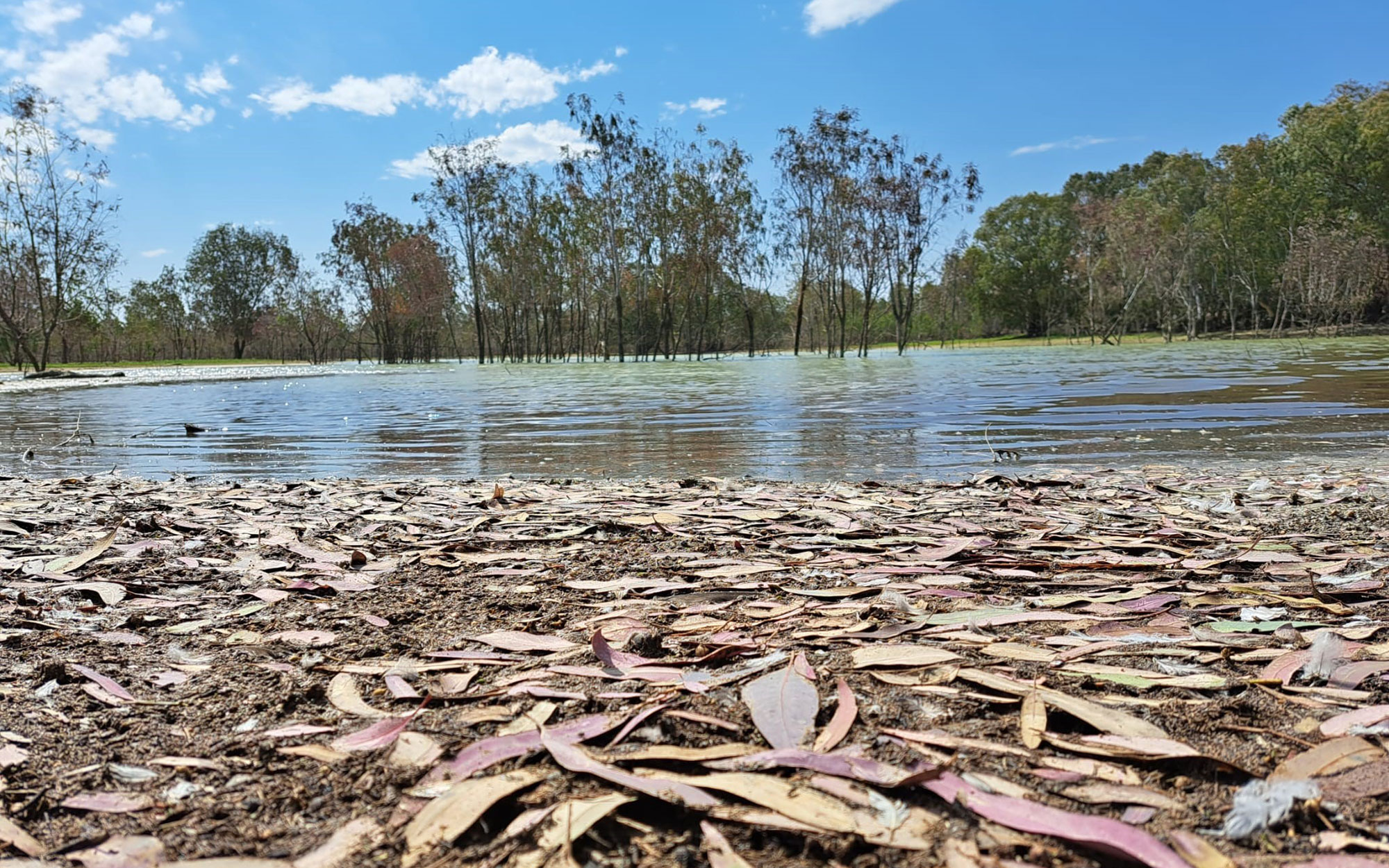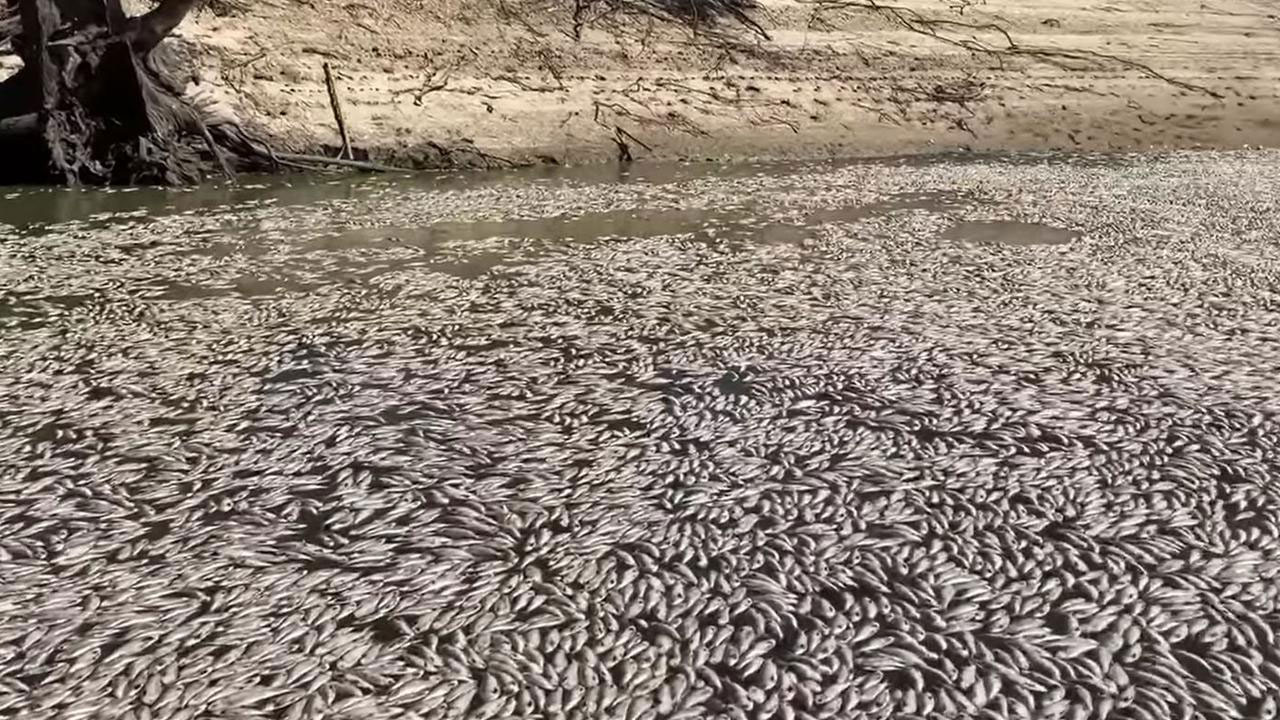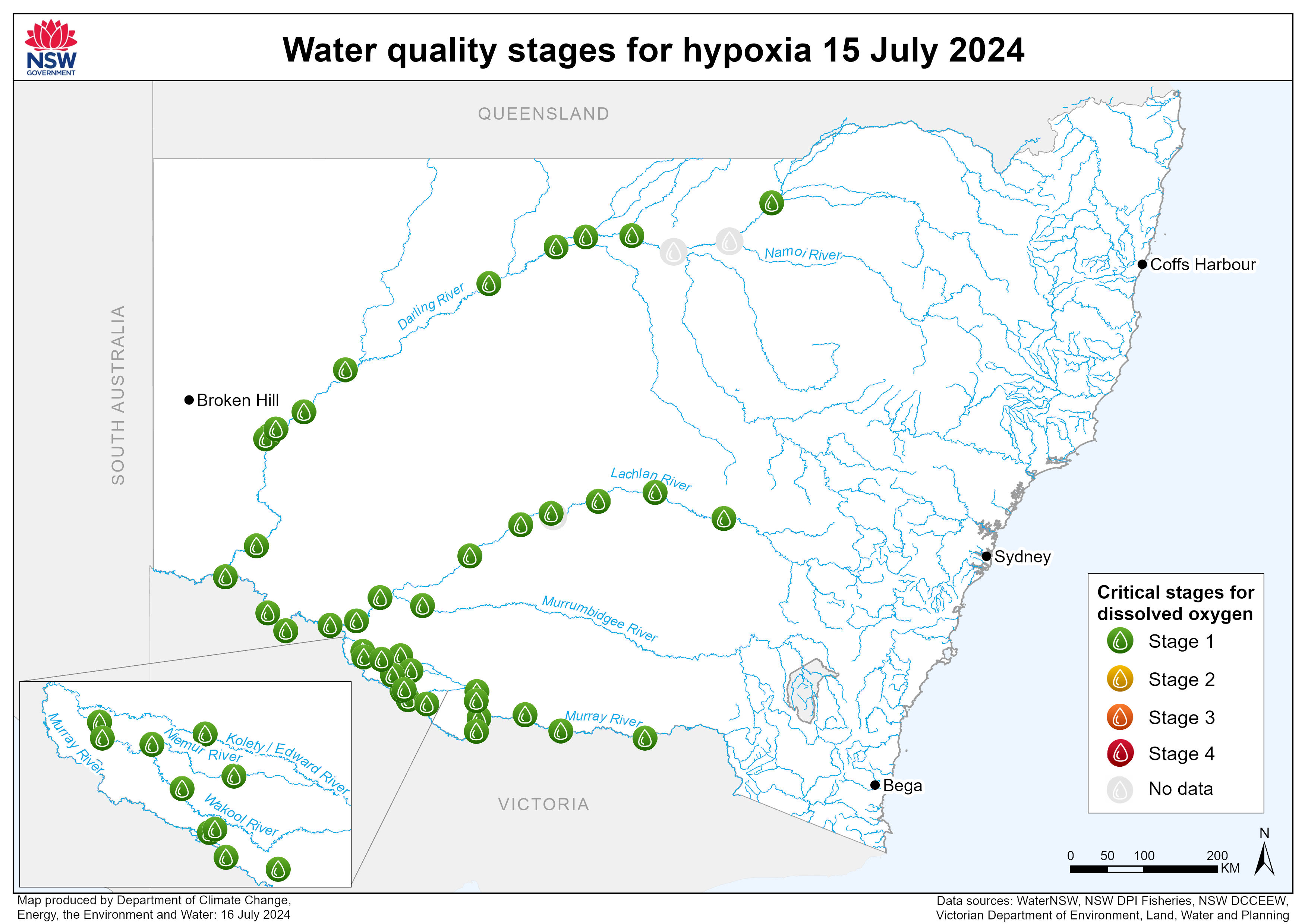What do the stages mean?
| Stage | Evidence |
|---|---|
Stage 1
|
|
Stage 2 Water quality monitoring has detected conditions which indicate a potential threat to the aquatic ecosystem.
| Any or all of:
|
Stage 3 Water quality presents an immediate threat to aquatic ecosystems. Urgent management response is required to avoid fish death or similar event of high ecological implications.
| Further deterioration of water quality conditions indicated by any, or all of:
|
Stage 4 Water quality is causing significant impact on aquatic ecosystems with potentially catastrophic outcomes – action is required to minimise or mitigate against further mass fish death.
|
|
Fish kills in Menindee
Fish kills in Menindee
Find information and updates on the ongoing monitoring and management of fish deaths in the Lower Darling-Baaka River at Menindee and downstream.
Dissolved oxygen water quality updates -
Murray Darling Basin
2024 updates
- Lower Darling River - water quality and flow release update - 17 July 2024 (PDF, 351.22 KB)
- Lower Darling River - water quality and flow release update - 11 April 2024 (PDF, 173.43 KB)
- Lower Darling River - water quality and flow release update - 8 March 2024 (PDF, 2464.17 KB)
- Lower Darling River - water quality and flow release update - 15 February 2024 (PDF, 642.26 KB)
2023 updates
- Lower Darling River - water quality and flow release update - 22 December 2023 (PDF, 926.73 KB)
- Lower Darling River - water quality and flow release update - 15 December 2023 (PDF, 2236.75 KB)
- Lower Darling River – water quality and flow release update - 4 December 2023 (PDF, 2099.61 KB)
- NSW Murray Darling Basin dissolved oxygen - water quality update - 17 November 2023 (PDF, 1858.83 KB)
- NSW Murray Darling Basin dissolved oxygen - water quality update - 26 October 2023 (PDF, 440.64 KB)
- NSW Murray Darling Basin dissolved oxygen - water quality update - 11 October 2023 (PDF, 184.35 KB)
- NSW Murray Darling Basin dissolved oxygen - water quality update - 23 August 2023 (PDF, 374.53 KB)
- NSW Murray Darling Basin dissolved oxygen - water quality update - 22 July 2023 (PDF, 426.1 KB)
- NSW Murray Darling Basin dissolved oxygen - water quality update - 3 July 2023 (PDF, 433.33 KB)
- NSW Murray Darling Basin dissolved oxygen - water quality update - 19 June 2023 (PDF, 389.52 KB)
- NSW Murray Darling Basin dissolved oxygen - water quality update - 8 June 2023 (PDF, 409.97 KB)
- NSW Murray Darling Basin dissolved oxygen - water quality update - 28 May 2023 (PDF, 352.65 KB)
- NSW Murray Darling Basin dissolved oxygen - water quality update - 18 May 2023 (PDF, 294.89 KB)
- NSW Murray Darling Basin dissolved oxygen - water quality update - 3 May 2023 (PDF, 583.53 KB)
- NSW Murray Darling Basin dissolved oxygen - water quality update - 27 April 2023 (PDF, 585.29 KB)
- NSW Murray Darling Basin dissolved oxygen - water quality update - 20 April 2023 (PDF, 520.1 KB)
- NSW Murray Darling Basin dissolved oxygen - water quality update - 13 April 2023 (PDF, 226.98 KB)
- NSW Murray Darling Basin dissolved oxygen - water quality update - 5 April 2023 (PDF, 603.02 KB)
- NSW Murray Darling Basin dissolved oxygen - water quality update - 29 March 2023 (PDF, 656.37 KB)
- NSW Murray Darling Basin dissolved oxygen - water quality update - 23 March 2023 (PDF, 678.97 KB)
- NSW Murray Darling Basin dissolved oxygen - additional water quality information - 23 March 2023 (PDF, 454.28 KB)
- NSW Murray Darling Basin dissolved oxygen - water quality update - 15 March 2023 (PDF, 213.83 KB)
- NSW Murray Darling Basin dissolved oxygen - water quality update - 8 March 2023 (PDF, 570.54 KB)
- NSW Murray Darling Basin dissolved oxygen - water quality update - 2 March 2023 (PDF, 242.11 KB)
- NSW Murray Darling Basin dissolved oxygen - water quality update - 24 February 2023 (PDF, 294.83 KB)
- NSW Murray Darling Basin dissolved oxygen - water quality update - 15 February 2023 (PDF, 584.72 KB)
- NSW Murray Darling Basin dissolved oxygen - water quality update - 8 February 2023 (PDF, 595.11 KB)
- NSW Murray Darling Basin dissolved oxygen - water quality update - 1 February 2023 (PDF, 826.5 KB)
- NSW Murray Darling Basin dissolved oxygen - water quality update - 24 January 2023 (PDF, 481 KB)
- NSW Murray Darling Basin dissolved oxygen - water quality update - 18 January 2023 (PDF, 806.61 KB)
- NSW Murray Darling Basin dissolved oxygen - water quality update - 11 January 2023 (PDF, 1078.53 KB)
2022 updates
- NSW Murray Darling Basin dissolved oxygen - water quality update - 20 December 2022 (PDF, 1286.69 KB)
- NSW Murray Darling Basin dissolved oxygen - water quality update - 14 December 2022 (PDF, 757.69 KB)
- NSW Murray Darling Basin dissolved oxygen - water quality update - 7 December 2022 (PDF, 363.84 KB)
- NSW Murray Darling Basin dissolved oxygen - water quality update - 29 November 2022 (PDF, 1301.54 KB)
- NSW Murray Darling Basin dissolved oxygen - water quality update - 22 November 2022 (PDF, 597.26 KB)
- NSW Murray Darling Basin dissolved oxygen - water quality update - 16 November 2022 (PDF, 986.7 KB)
- NSW Murray Darling Basin dissolved oxygen - water quality update - 10 November 2022 (PDF, 898.21 KB)
- NSW Murray Darling Basin dissolved oxygen - water quality update - 1 November 2022 (PDF, 955.64 KB)
- NSW Murray Darling Basin dissolved oxygen - water quality update - 25 October 2022 (PDF, 806.81 KB)
- NSW Murray Darling Basin dissolved oxygen - water quality update - 17 October 2022
- NSW Murray Darling Basin dissolved oxygen - water quality update - 10 October 2022 (PDF, 839.7 KB)
- Media release: Risk of hypoxic blackwater event in inland rivers - 30 September 2022
- NSW Murray Darling Basin dissolved oxygen - water quality update No. 8 - 14 April 2022
- NSW Murray Darling Basin dissolved oxygen - water quality update No. 7 - 14 March 2022
- NSW Murray Darling Basin dissolved oxygen - water quality update No. 6 - 16 February 2022
- Media release: Managing the risk of a significant hypoxic blackwater event at Menindee Lakes - 7 February 2022
- NSW Murray Darling Basin dissolved oxygen - water quality update No. 5 - 7 February 2022 (PDF, 703.19 KB)
- NSW Murray Darling Basin dissolved oxygen - water quality update No. 4 - 28 January 2022 (PDF, 648.4 KB)
- NSW Murray Darling Basin dissolved oxygen - water quality update No. 3 - 17 January 2022 (PDF, 927.01 KB)
2021 updates
Dissolved oxygen water quality updates -
Southern Basin
2020 updates
- Hypoxic blackwater update No. 2 - 18 December 2020 (PDF, 468.24 KB)
- NSW Southern Basin Dissolved Oxygen Update No. 7 - 7 December 2020 (PDF, 419.25 KB)
- NSW Southern Basin Dissolved Oxygen Update No. 6 - 23 November 2020 (PDF, 641.73 KB)
- NSW Southern Basin Dissolved Oxygen Update No. 5 - 9 November 2020 (PDF, 582.26 KB)
- NSW Southern Basin Dissolved Oxygen Update No. 4 - 26 October 2020 (PDF, 401.29 KB)
- NSW Southern Basin Dissolved Oxygen Update No. 3 - 15 October 2020 (PDF, 568.3 KB)
- NSW Southern Basin Dissolved Oxygen Update No. 2 - 28 September 2020 (PDF, 850.85 KB)
- Hypoxic blackwater update No. 1 - 22 September 2020 (PDF, 368.82 KB)
- NSW Southern Basin Dissolved Oxygen Update No. 1 - 21 September 2020 (PDF, 565.85 KB)
Historic Blackwater events
Hypoxic blackwater events are a natural occurrence and they do not always lead to fish deaths. Fish deaths that are likely linked to hypoxic blackwater have been reported in the Barwon and Darling Rivers, as well as the southern Basin since the late 1800s.
The newspaper accounts, dating from 1884, are focussed on the Barwon and Darling Rivers.
The links below are reports from the Murray River from as far back as 1892.
- 21 Jan 1892 - Pollution of the River Murray
- 12 Jan 1892 - Strange fish epidemic
- 08 Mar 1892 - Our river fish
- 31 Jan 1896 - Condition of Cook's River
- 30 Mar 1900 - Disease among fish
- 14 Feb 1919 - Smothered fish
- 13 Jan 1927 - Tons of fish killed
- 02 Nov 1929 - Big fish loss on Murray
- 09 Nov 1929 - What's wrong with the Murray?
- 21 Nov 1929 - Dead fish in the Darling
- 01 Nov 1929 - Wholesale death of river fish
- 29 Jan 1930 - Fish in the Murray
- 21 Mar 1930 - Fish dying in the Paroo
- 15 Nov 1929 - The river fish
- 02 Aug 1938 - Mystery river deaths
- 01 Aug 1938 - Bream dying in Murray
- 23 Aug 1938 - Mortality of Murray fish investigated
- 25 Aug 1938 - Mortality of Murray fish

Learn the basics about hypoxic water, what it is and why it matters.
Further information
The Department of Climate Change, Energy, Environment and Water (DCCEEW) has information on hypoxic blackwater events and water quality.
You can find maps of water quality threats and a short video on blackwater at the Murray–Darling Basin Authority website.
Real-time water data by WaterNSW includes DO values for some river gauges in NSW.

